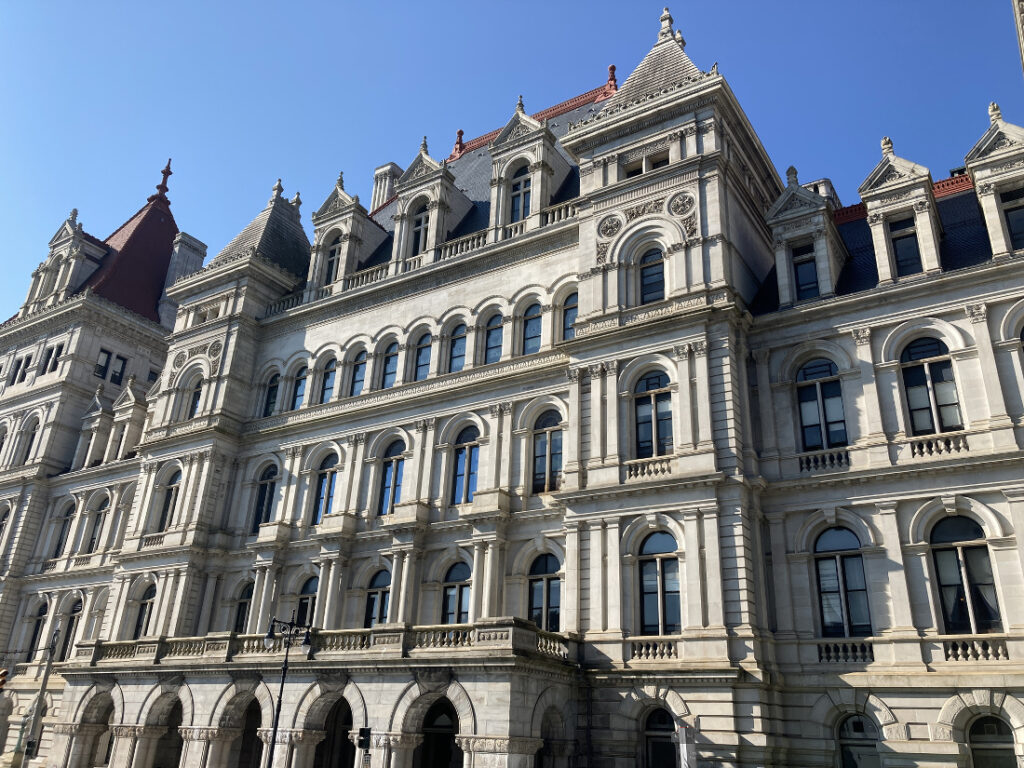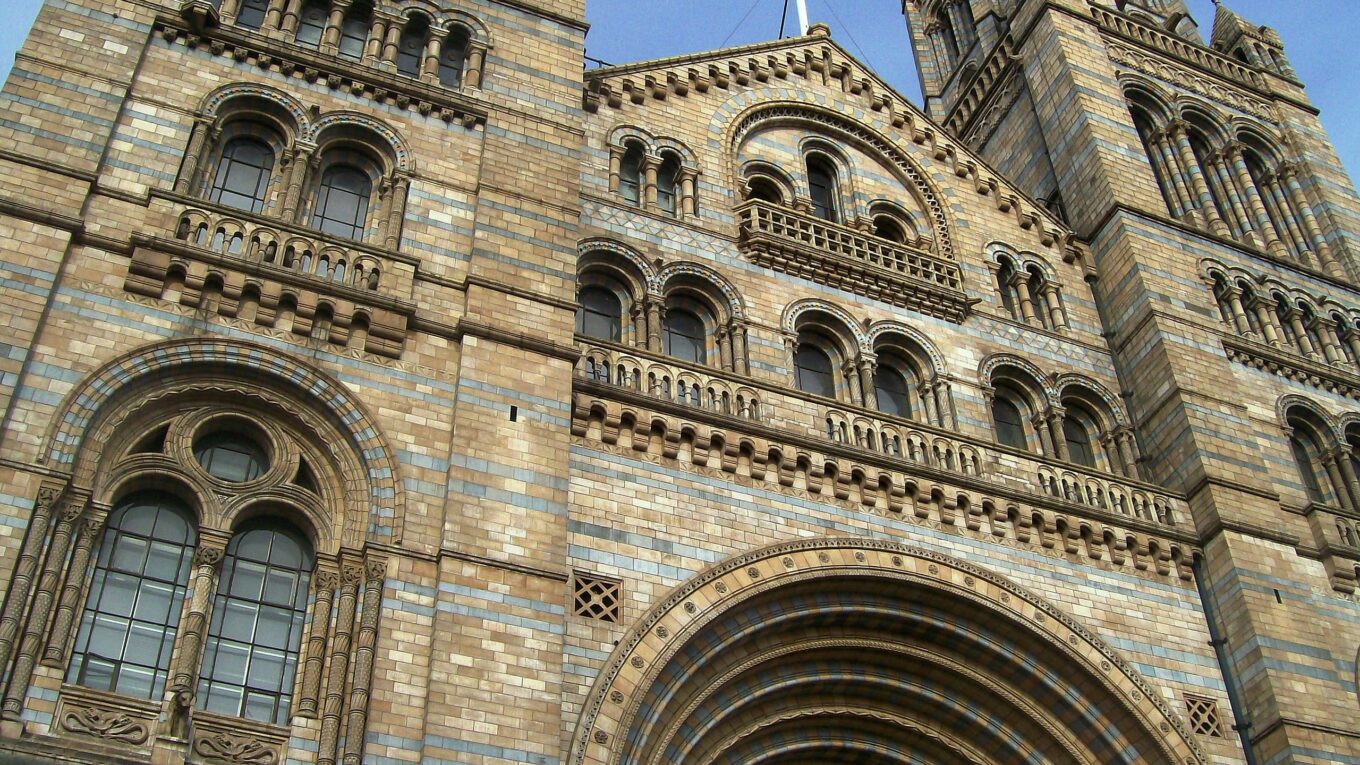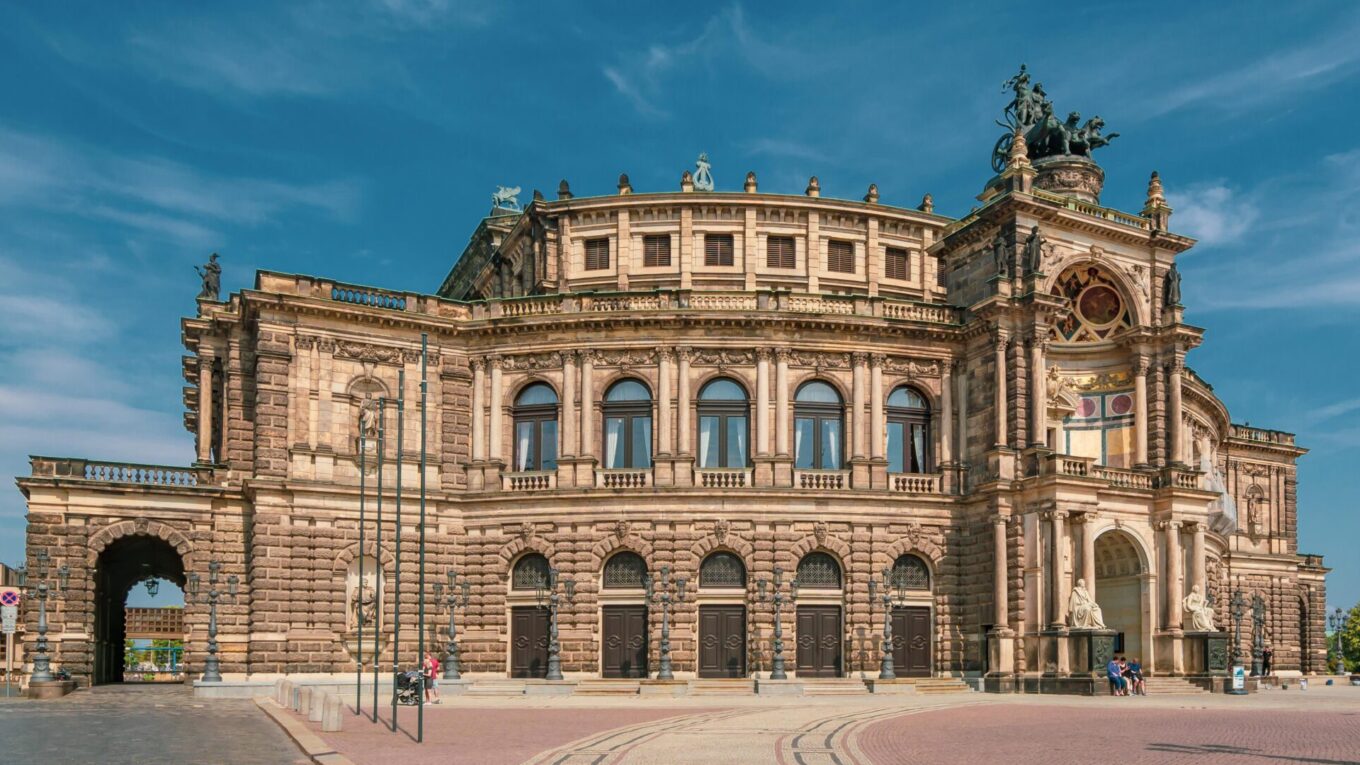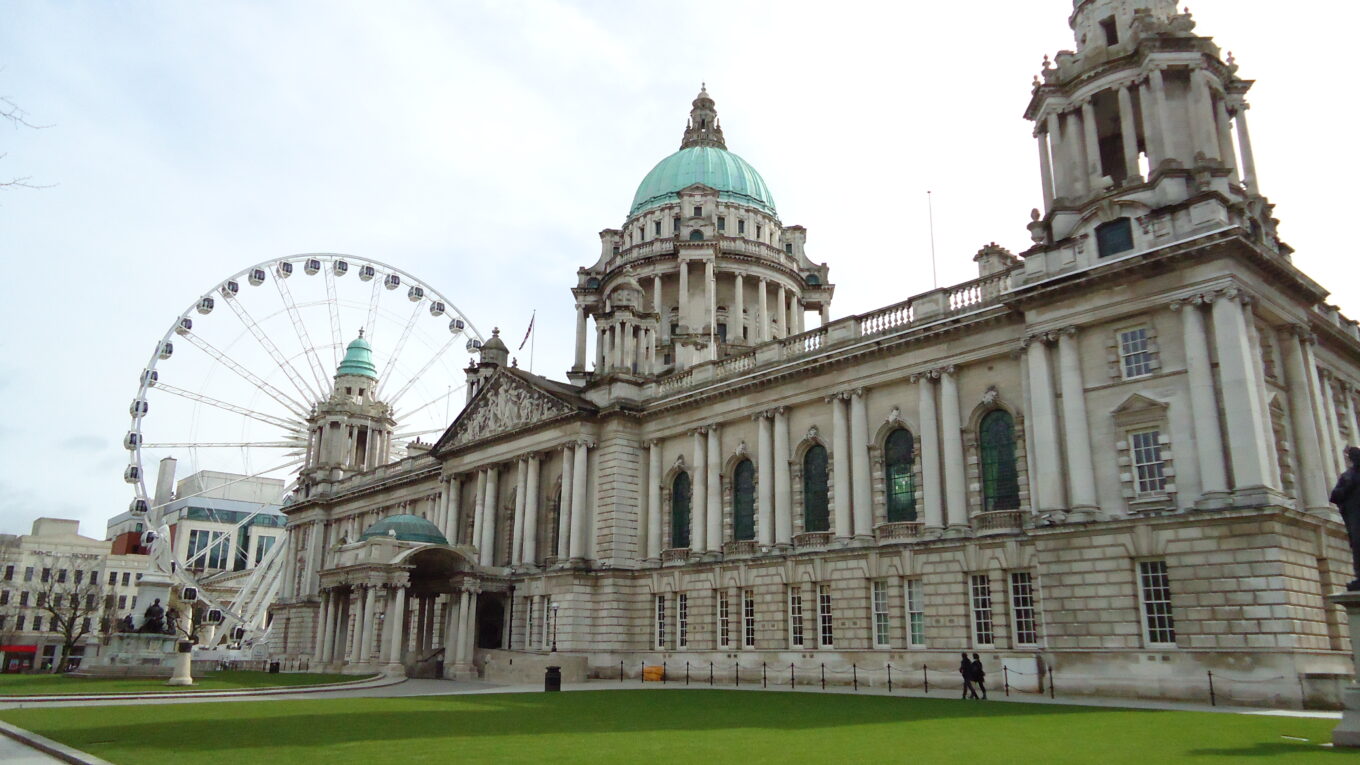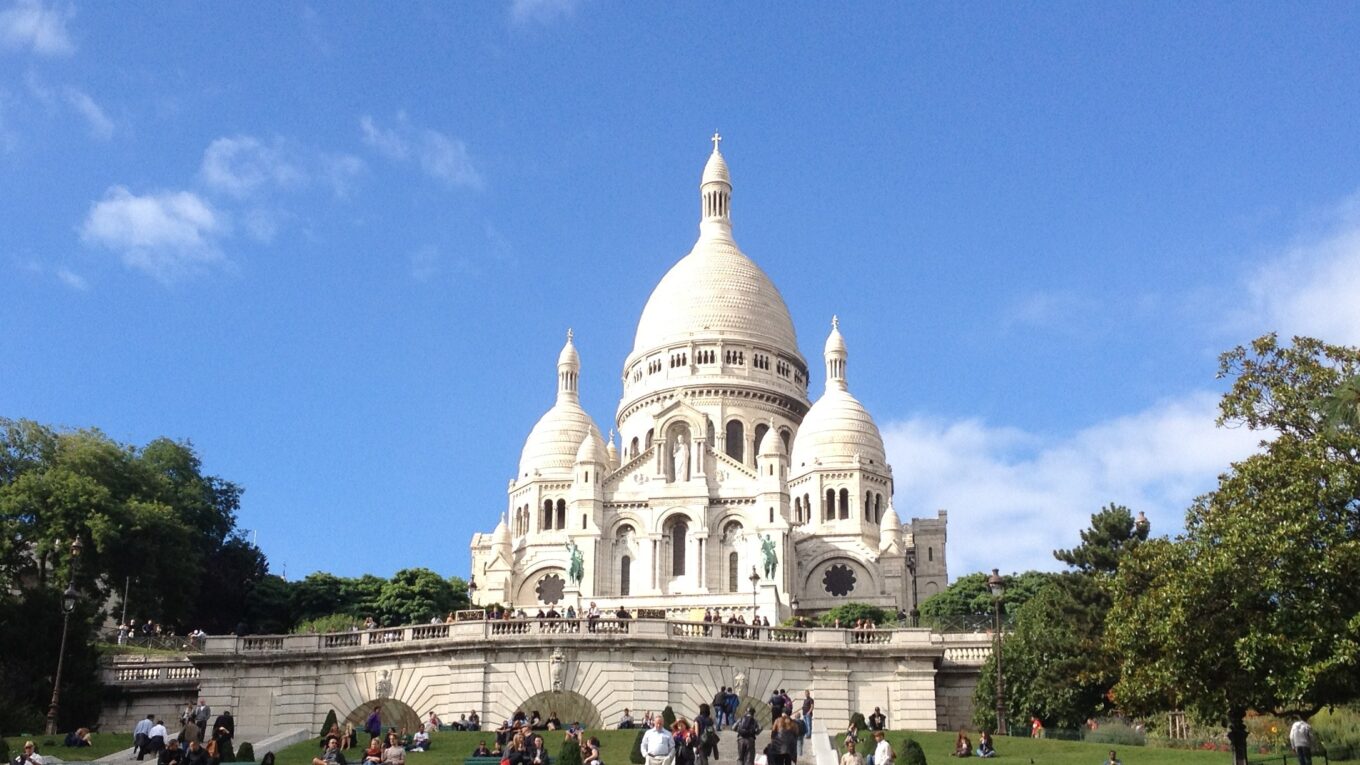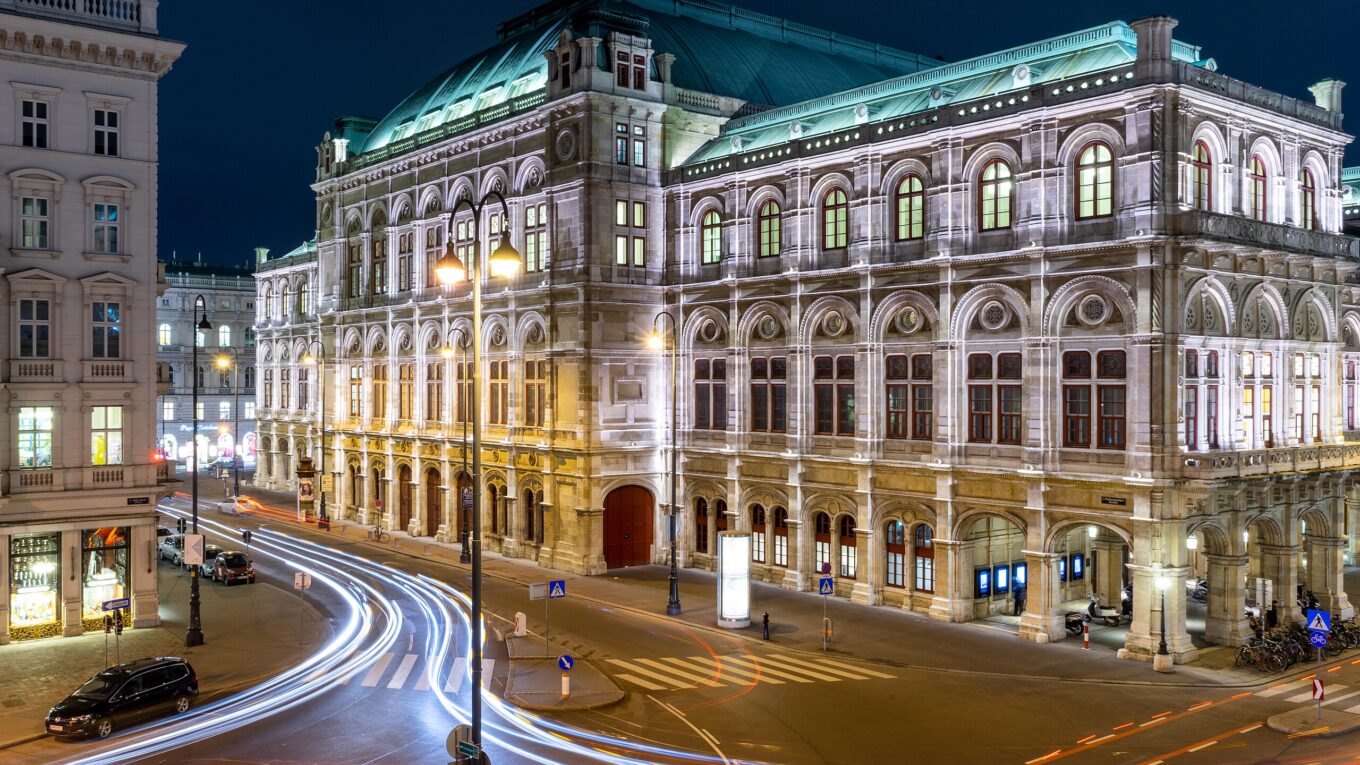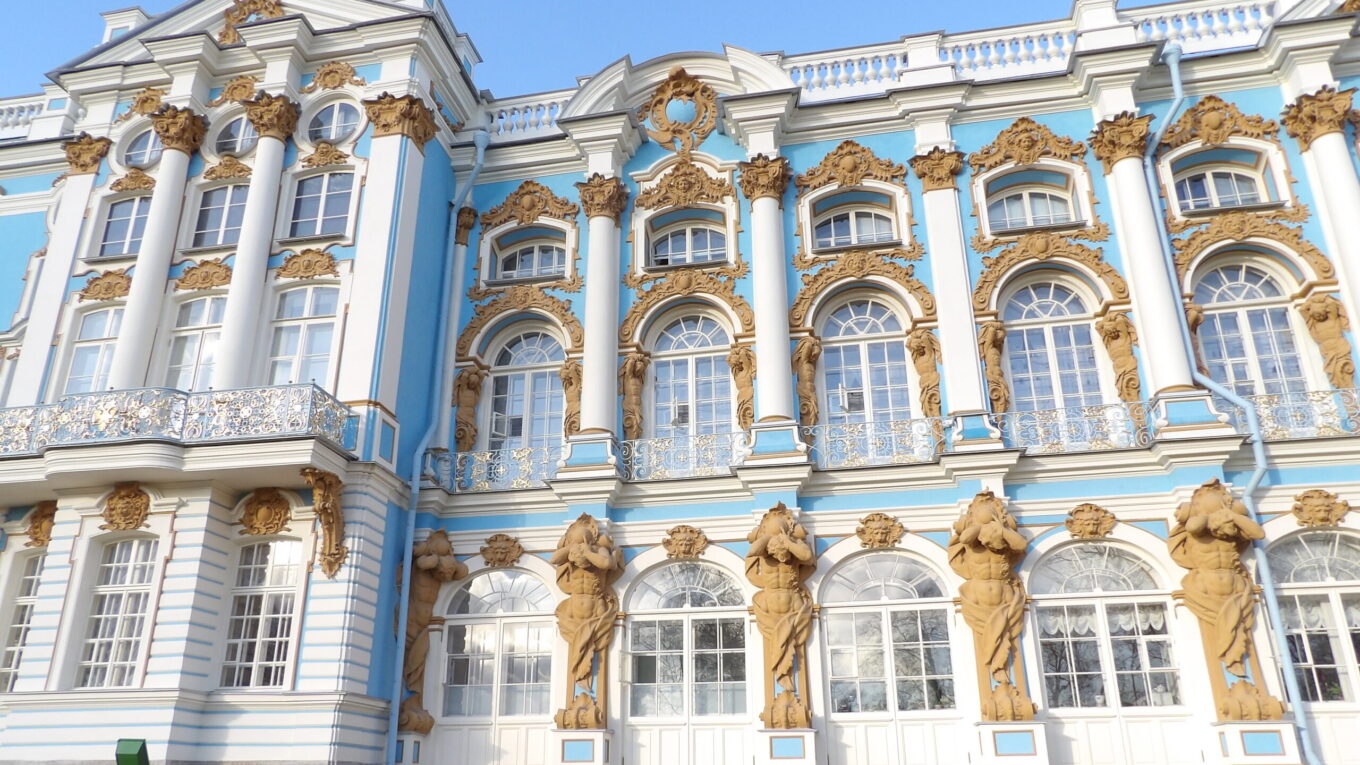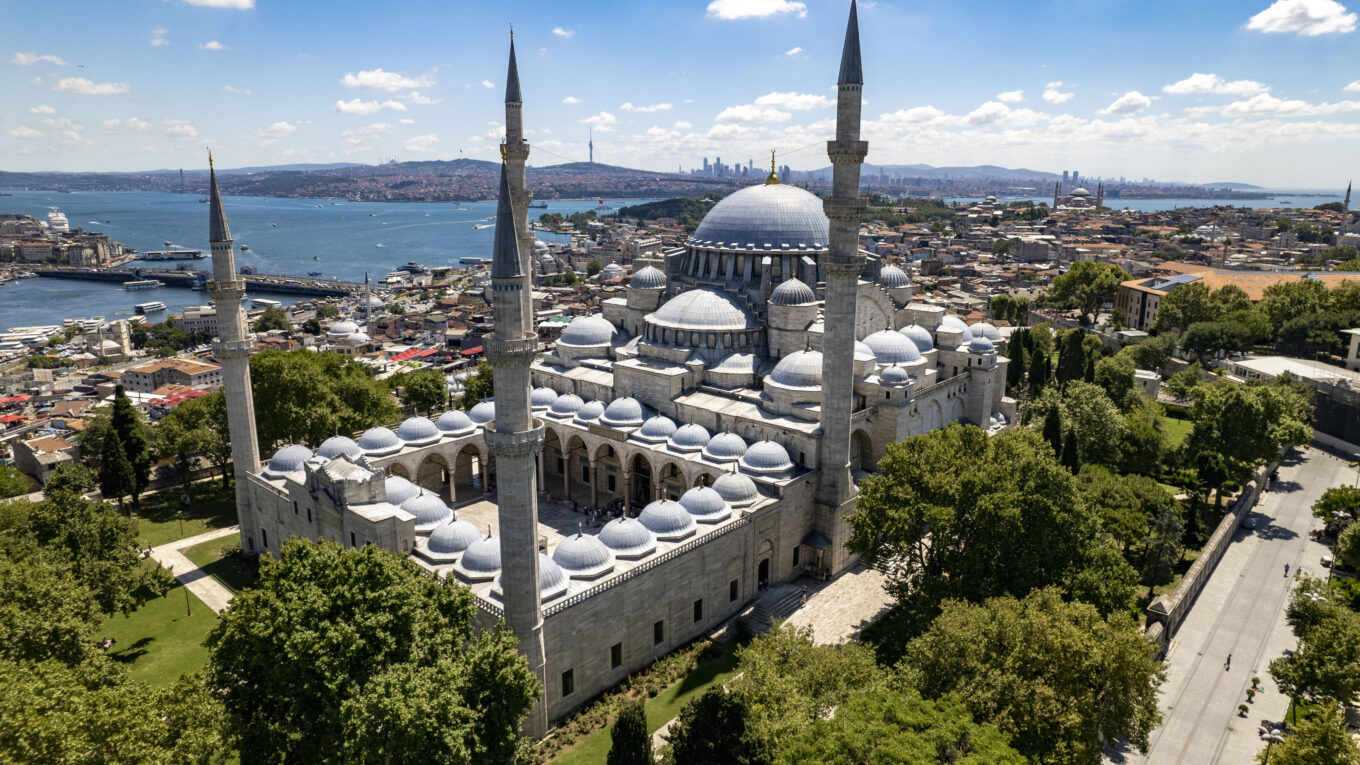Top 15 Examples of Romanesque Revival Architecture
Romanesque Revival Architecture, also known as Neo Romanesque Architecture, was a building style that reached its peak in popularity during the late 19th and early 20th centuries. It was a major style within the Revival Movement, which was a period when most architecture was designed to replicate the buildings of the past. Romanesque Revival Architecture coexisted alongside other revival styles, including Neoclassical, NeoByzantine, NeoGothic, NeoRenaissance, and NeoBaroque. Romanesque Revival Architecture can be found throughout the world, particularly in the United States, Canada, and Western Europe. The list below will highlight 20 of the World’s Greatest Examples of Romanesque Revival Architecture, and describe the history, characteristics, and impact of the Neo Romanesque Style.
When was the Romanesque Revival Period?
The Romanesque Revival period was a movement in architecture that emerged in the mid-19th century and continued up until the early 20th century. It was part of a larger movement in architecture known as the Revival Period.
There are many different styles of Revival Architecture, but they all revolve around the same theme: replicating the buildings of the past and redesigning them in a new way.
Romanesque Revival Architecture coexisted alongside other revival styles, including NeoByzantine, Neoclassical, NeoGothic, NeoRenaissance, and NeoBaroque.
Eventually, during the 1920s and 30s, other more fluid and sculptural building forms became popular including Art Nouveau and Art Deco Architecture.
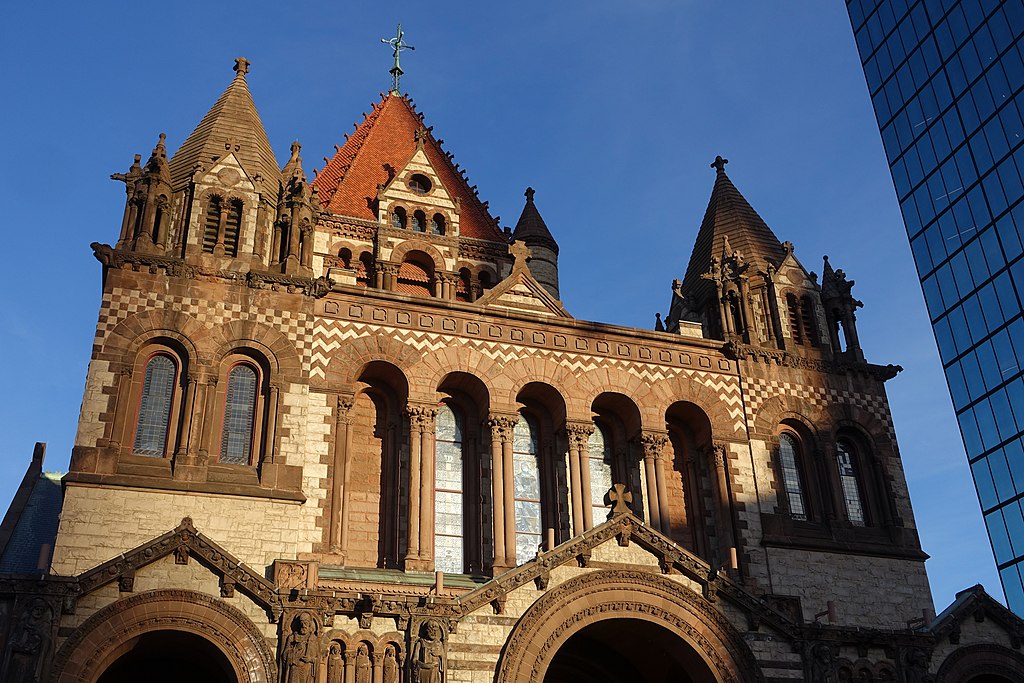
What was the Romanesque Age?
The Romanesque Age was a period in history that began in the 10th century and lasted until the start of the Gothic Age in the 12th Century. Romanesque Architecture was an early building form that utilized a lot of simple geometries and forms such as round arches and arched vaults. Many of these elements were inspired by the Ancient Roman Ruins that were found throughout Europe at this time. Romanesque Revival Architecture is designed to mimic earlier examples of Romanesque Architecture by using similar features and characteristics.
The image below shows Speyer Cathedral in Germany – here the left portion of the building with the dark-red masonry, dates to the original Romanesque Age in the 11th century – while the right portion of the building, with the light-colored masonry, was constructed during the Revival Period during the 1850s.
The new portion from the Romanesque Revival Period utilizes the same geometries and details as the original church and attempts to replicate and reinvent the original architecture.

What’s the difference between Romanesque Revival Architecture and NeoRomanesque Architecture?
There is no difference between NeoRomanesque Architecture and Romanesque Revival Architecture, and the terms are often used interchangeably. Virtually all of the styles from the Revival Period in Architecture can also be described in this manner. (Ie…NeoGothic vs. Gothic Revival and NeoRenaissance vs. Renaissance Revival)
Characteristics of Romanesque Revival Architecture
The big idea behind Romanesque Revival Architecture is the replication of older buildings from the Romanesque Period. Romanesque was the first style to emerge in Europe after the fall of the Roman Empire, and it borrowed many elements from older Roman Buildings. The main difference between regular Romanesque and Romanesque Revival is the advances in technologies that occurred between the 11th and 19th centuries. Romanesque Revival buildings are much lighter and airier than their older counterparts, and new technologies allowed for greater spans and larger windows than in original Romanesque Buildings.
Round Arches
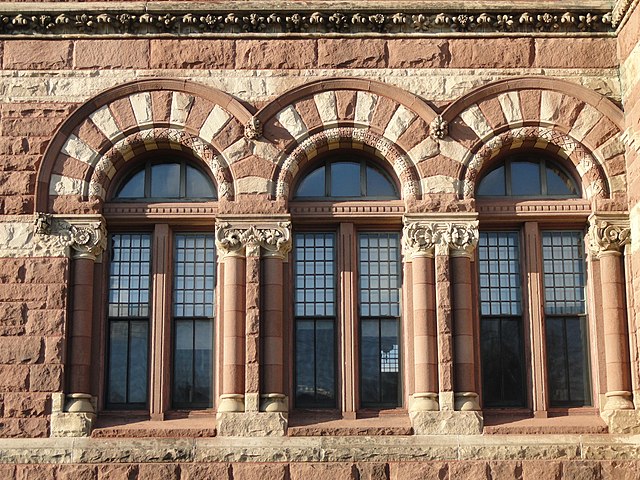
By far the most emblematic element found in Romanesque Architecture is the use of round arches. These arches are sometimes called “Roman Arches” because they were widely utilized in Ancient Roman Architecture. Round arches are noticeably different than the pointed arches found throughout Gothic Architecture, and they are an easy way to distinguish Romanesque vs. Gothic buildings. Here at the Woburn Public Library in Woburn Massachusetts, you can see a series of round arches that are constructed with multi-colored stone.
Towers & Turrets
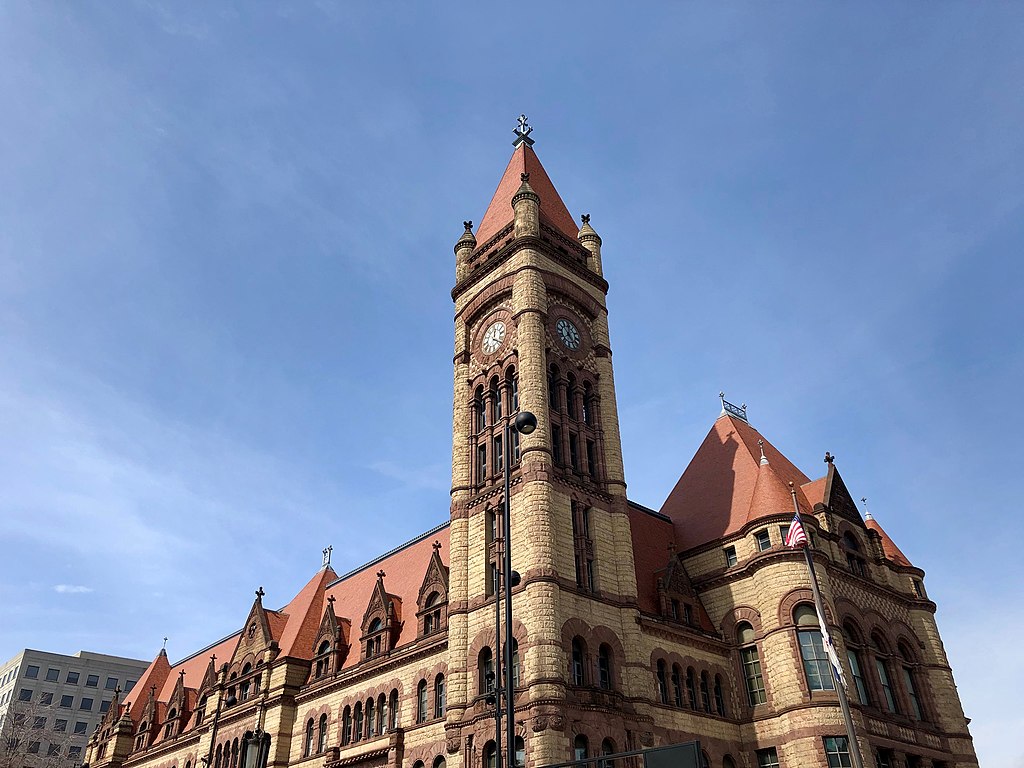
Towers and turrets can be found in many great examples of Romanesque Revival Architecture. The original Romanesque Age occurred during the early Medieval Period when most European cities were fortified with walls, towers, and moats. The buildings of the Romanesque Revival Period also utilize towers and turrets as a way to mimic older historic buildings and resemble the architecture of the Medieval era. In the image above you can see the tower of Cincinnati City Hall which resembles many fortified towers from the Middle Ages.
Thick Walls
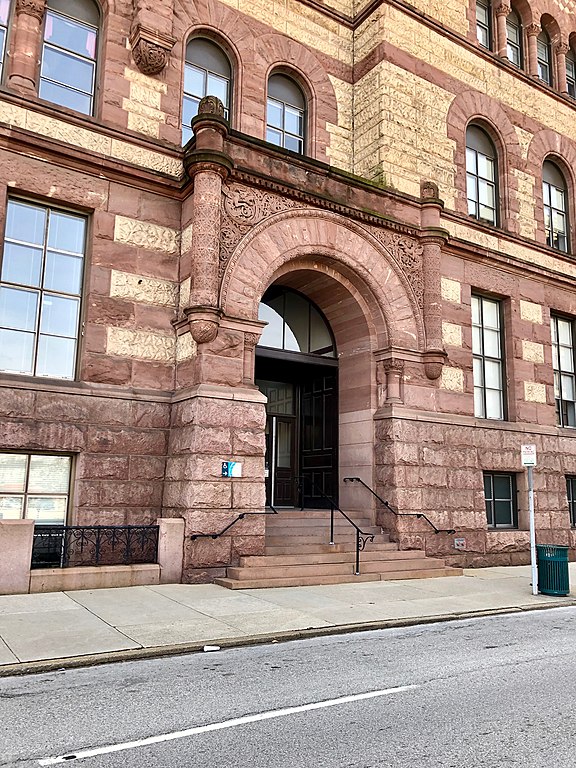
The original Romanesque Style emerged in the early Medieval Period, from the 10th to the 12th centuries. This was right after the Dark Ages when there was little technical innovation in Europe. As a result, most Romanesque Architecture is very boxy, and thick looking, with walls that had to be thick and stout to support the weight of the roof overhead. This idea is replicated in Romanesque Revival Architecture, although during the 19th century, these thick walls weren’t as necessary. In the image above you can see the walls at the base of Cincinnati City Hall. Here the masonry is several feet thick. Even though these walls don’t support much weight overhead, there still constructed at a great depth as a way to resemble older Romanesque Buildings.
Simple Spacial Geometries
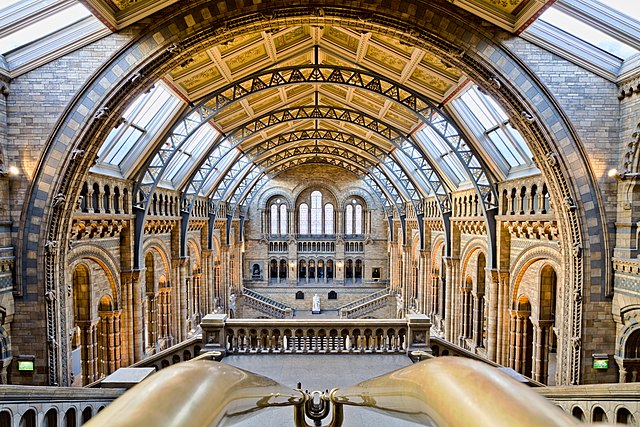
Simplistic Geometry is another key feature found in Romanesque Revival Architecture. Forms like barrel vaults, arcades, and round & rectangular spaces can be found throughout Romanesque Designs. These forms can also be found throughout Classical Architecture, but they are greatly simplified compared to other geometries found in later works from the Gothic, Renaissance, and Baroque Ages. In the image above you can see the famous barrel vault within the Museum of Natural History in London. Here the span of the arches is made possible with the help of metal supports that line the underside of the masonry. These were a new technology at the time, which only emerged in the Revival Period.
Small Windows

Small windows are another key element in Romanesque Revival Architecture. During the original Romanesque Age, most windows were small because they had to be. Builders just weren’t capable of creating the larger windows that were popularized in the Gothic Age. But in 19th century Neo Romanesque Architecture, small windows are still utilized as a way to replicate older Romanesque Buildings. Here you can see some windows on the side of Cincinnati City Hall, in Cincinnati, Ohio, United States.
“Defensive” Architectural Elements

Many Romanesque Revival Buildings include details that were once found in defensive military architecture from the Romanesque Age. These details include crenellations, thick walls, and towers. Back in the original Romanesque Age of the 11th and 12th centuries, all of these elements served a purpose by helping defenders during a siege. During the Revival Age of the 19th century, many of these elements can still be seen, however. they are strictly decorative. The image above shows the tower of Albany City Hall in Albany, New York. Here you can see what are often referred to as “arrow slits” within the exterior of the tower. In the medieval period. these narrow openings allowed for a defender to shoot arrows at the enemy while still being protected – but during the 19th century, they were only added to mimic older Romanesque structures.
Geometric Detailing
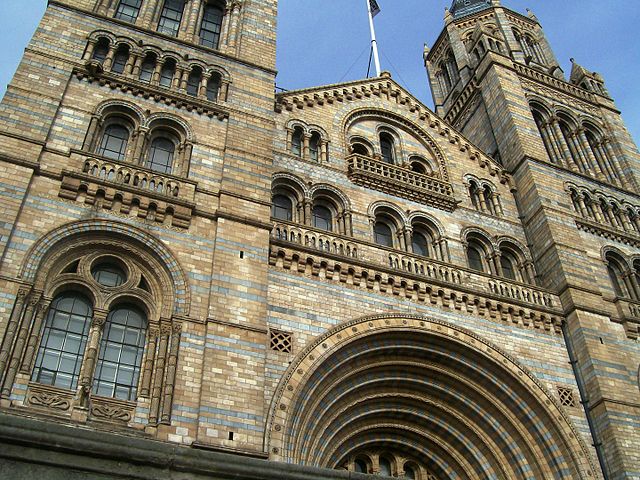
Romanesque Architecture is a much more subdued style when compared to later styles like Gothic and Baroque. Many Romanesque Buildings are detailed with simple geometric patterns, and subtle ornamental brickwork. This theme is replicated throughout Romanesque Revival Architecture, which focuses more on bold forms rather than intricate details. Here at the Museum of Natural History in London, you can see the main facade has lots of simple details worked into the masonry. They’re not flashy and complicated and are more like accents around the regular geometries of the building.
Stacked Masonry Construction
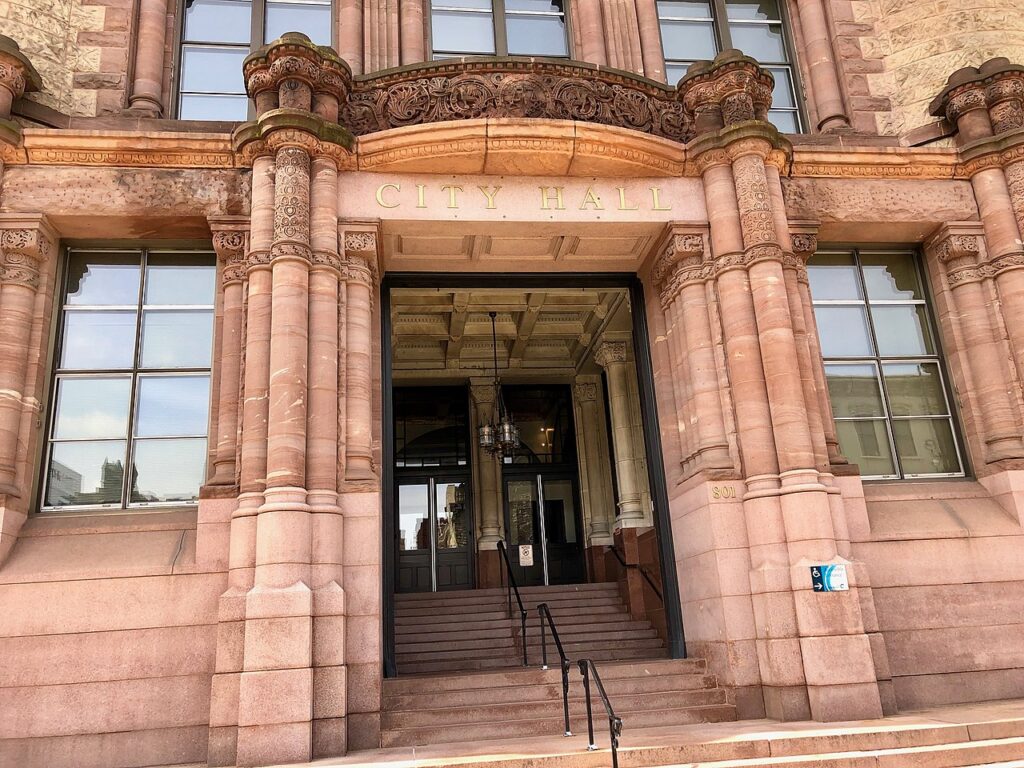
Some people regard the late 19th century as the peak for stacked masonry construction. Most modern buildings aren’t made entirely of brick and stone, instead, they utilize a steel skeletal structure with masonry that is just a thin veneer. During the 19th century, however, most buildings were built using a technique known as “stacked masonry.” This means the masonry units were literally stacked on top of one another, with the whole weight of the building resting on the masonry. This technique died out in the early 1900s when steel became much more cost-effective. Some of the final examples of this type of construction date to the Revival Age. The image above shows the masonry foundations of Cincinnati City Hall, which utilizes stacked masonry construction.
What are the best examples of Romanesque Revival Architecture?
Romanesque Revival Architecture was one of the key typologies within the overall Revival Movement. The list below will highlight 20 of the World’s Greatest Examples of Romanesque Revival Architecture, and provide an in-depth look at the history and importance of the Romanesque Revival Style.
1. Museum of Natural History – London, England, UK

One of the world’s greatest examples of Romanesque Revival Architecture is the London Museum of Natural History. It was completed in 1881 and has been open to the public ever since. The museum houses an incredible collection of artifacts and exhibits that tell the story of life on Earth and the various plants and animals that exist alongside humans. The image above shows the front facade of the museum, which greatly resembles many Romanesque Cathedrals located all across Europe.
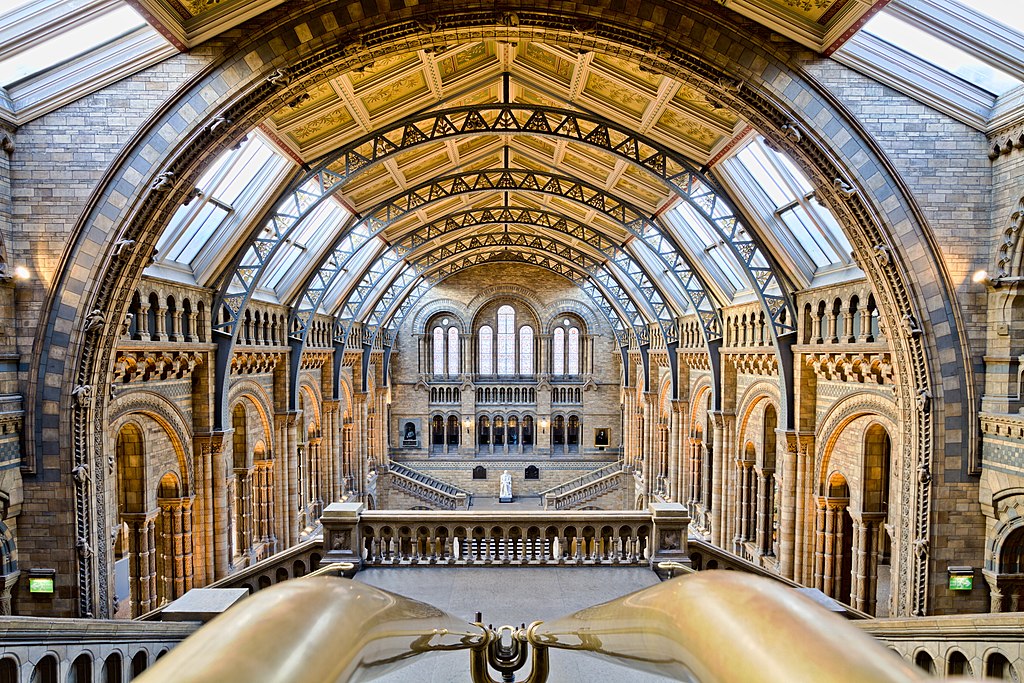
London has always had strong ties with the Romanesque Style, and some of the city’s most notable buildings date from this time period. The White Tower at the center of the Tower of London was constructed in the Romanesque Style by William the Conqueror, shortly after his victory at the Battle of Hastings in 1066. The Tower of London remains a symbol of the city, and it’s no surprise that many architects took inspiration from older works of Norman Architecture throughout the Revival Period. Today the London Museum of Natural History is among the most visited buildings in the entire city, and it’s one of the world’s greatest natural history museums.
2. Trinity Church – Boston, Massachusetts, United States
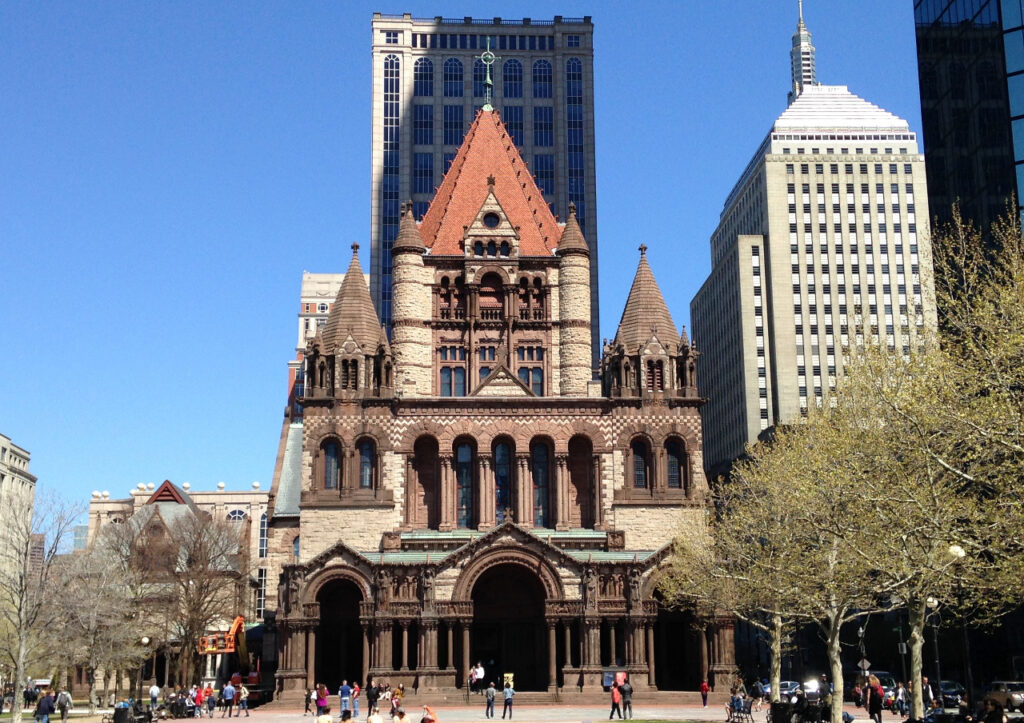
Trinity Church is a large church in the middle of Boston, Massachusetts. It was completed in 1877, and designed by Henry Hobs Richardson. Richardson was a famous architect at the time who worked almost exclusively in the Romanesque Revival Style. The church is regarded as one of Richardson’s greatest works, and it’s one of the most iconic buildings in downtown Boston. It overlooks Copley Square and is located next to other important monuments, including the Boston Public Library and the John Hancock Building. H.H. Richardson designed dozens of Romanesque Revival Buildings and he inspired other architects over the years, which gave rise to a sub-type of the style known as Richardsonian Romanesque.


These images show some of the exquisite details located throughout the facade of Trinity Church. Most of the exterior is composed of a two-tone color scheme made from different shades of Red Sandstone. This technique was utilized extensively by Richardson, and red sandstone can be found throughout many of the different buildings on this list. Today Trinity Church is a protected landmark within Boston, and it continues to serve as one of the city’s most important religious buildings.
3. New York State Capitol – Albany, New York, United States

The New York State Capitol Building is a work of Romanesque Revival Architecture located in Albany, New York. Like so many buildings from this time period, the NY Capitol Building is composed of a variety of architectural styles. Romanesque has the strongest influence, but there are also many elements from Renaissance Revival Architecture and Byzantine Revival Architecture. The building is the centerpiece of the New York State Capitol Complex, which is located atop a large hill in central Albany. In addition to the Capitol Building, there are other impressive structures, most of which date from a large-scale development project that was completed in 1976.

Construction on the NY State Capitol Building took over 32 years, and several different architects were involved. One of the main designers was H.H. Richardson, who was one of the most famous architects of the age. Richardson and the other architects each added their own touches to the design, which partially explains the eclectic nature of the building. Today the New York State Capitol Building still houses several functions within the NY State Government, and it’s among the many great Capitol Buildings found throughout The United States.
4. Fisherman’s Bastion – Budapest, Hungary

Photo by Nikolai Karaneschev from Wikimedia Commons
The Fisherman’s Bastion is a great example of Romanesque Revival Architecture in the Hungarian capital of Budapest. Although it wasn’t actually constructed for defensive purposes, it’s still known as a “Bastion” because it is a Romanticized version of a fortification from the Romanesque Age. Fisherman’s Bastion also contains a large monumental staircase that connects the upper part of the Buda side of Budapest down to the Danube River below. Today, Fisherman’s Bastion is one of the most popular spots in the city, thanks to its impressive views over all of Budapest.
5. Smithsonian Castle – Washington DC, United States
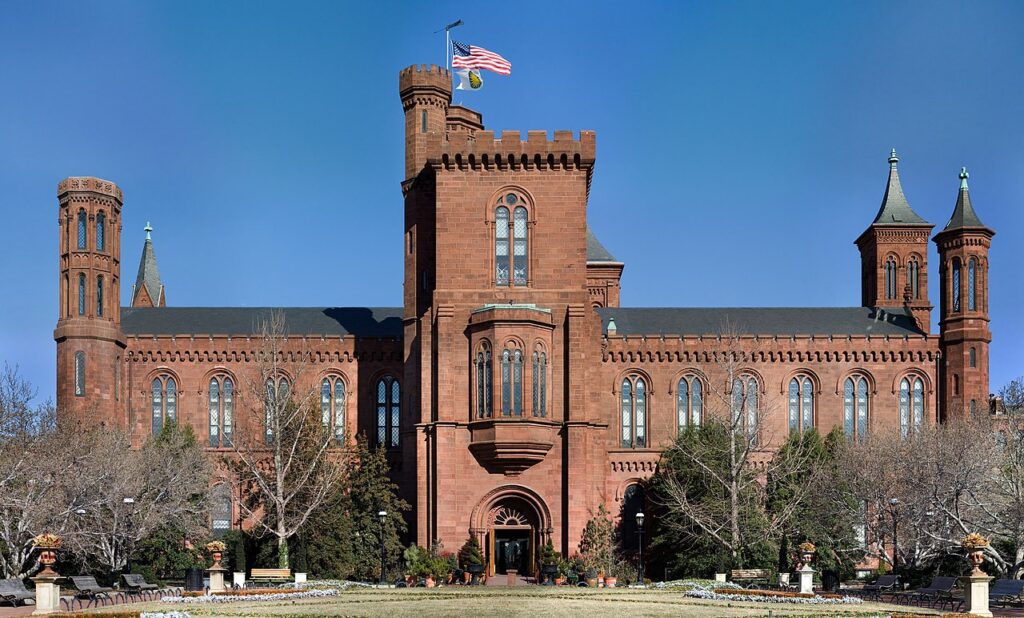
The Smithsonian Castle is one of the most important works of Romanesque Revival Architecture in The United States. It was completed in 1855, and it was one of the original buildings in the Smithsonian Museum Complex within the National Mall in Washington DC. The building itself is a blend of Romanesque Revival mixed with elements from other Medieval Castles. Today Smithsonian Castle no longer functions as a museum, and it contains offices and other service functions for the Smithsonian Organization.
6. Basilica of Notre-Dame de Fourvière – Lyon, France

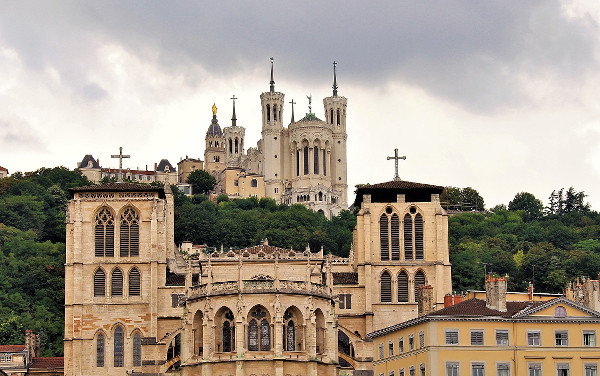
Perched on a hilltop overlooking the city of Lyon, the Basilica of Notre-Dame de Fourvière is one of France’s greatest examples of Romanesque Revival Architecture. The church contains an eclectic blend of elements, and it has a unique appearance unlike most of the traditional Romanesque Churches located throughout Western Europe. It was constructed with private money during the late 19th century, and the French state and the city of Lyon had little to do with its construction. There are a few examples of this in France, most notably the Byzantine Revival Style Church of Sacré-Cœur in Paris. Overall the Basilica of Notre-Dame de Fourvière is a very notable building within Lyon and its unique appearance makes it unlike many other churches from this time period.
Like Architecture of Cities? Sign up for our mailing list to get updates on our latest articles and other information related to Architectural History.
7. Salt Lake City Hall – Salt Lake City, Utah, USA
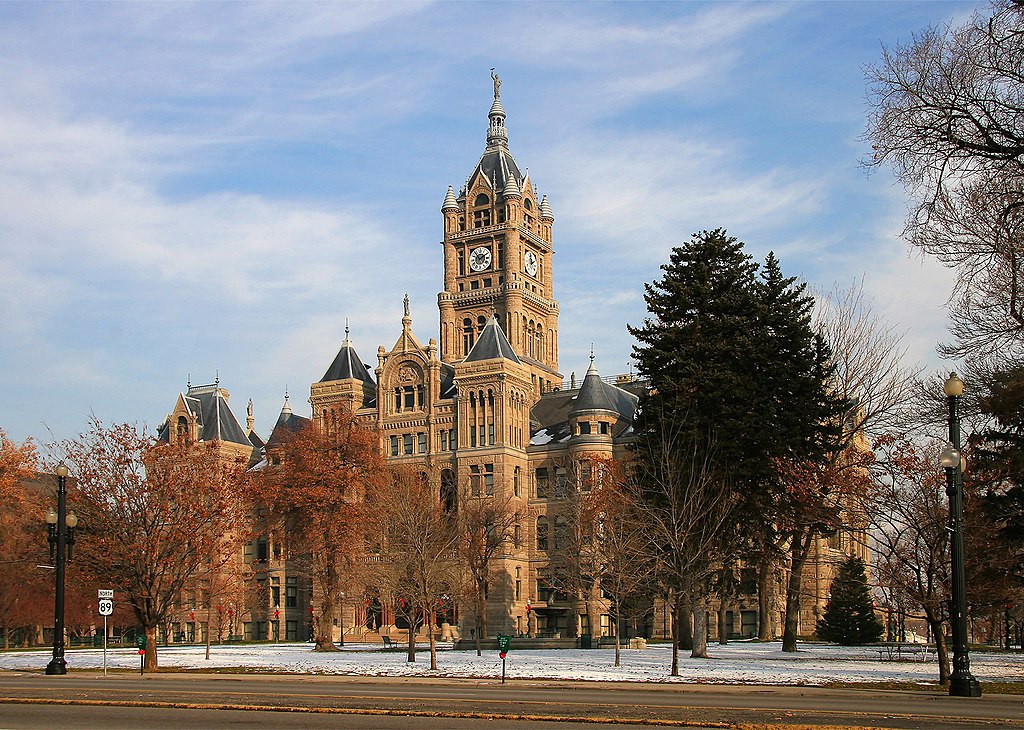
Salt Lake City Hall houses the local government of Salt Lake City. It was constructed beginning in 1891 in the Romanesque Revival Style. Romanesque Revival was particularly popular with many turn-of-the-century government buildings located in The United States. The design of Salt Lake City Hall contains many of the typical elements found in Romanesque Revival Architecture, including thick masonry walls, round arches, and turrets. The building also contains a central clocktower that stands over 250 feet (76 m) tall, and it was one of the tallest structures in the city at the time of its completion.
8. Old Toronto City Hall – Toronto, Ontario, Canada
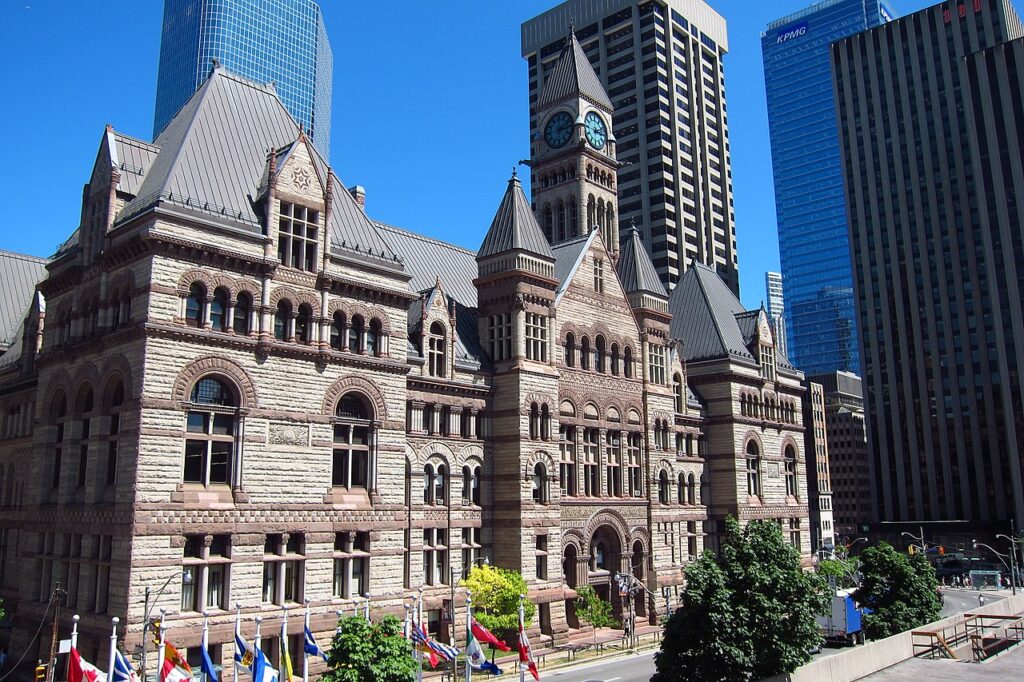
Old Toronto City Hall is a large municipal building overlooking Nathan Phillips Square in downtown Toronto. The building was designed in the Romanesque Revival Style, and it has a very similar appearance to many other Neo Romanesque Buildings, including Cincinnati City Hall and the Woburn Public Library. Old Toronto City Hall was completed in the year 1899, and it housed the local Toronto Government until a newer city hall was completed in the 1960s. Both the new and old city halls are located adjacent to one another and they epitomize the blend of historic and contemporary architecture that can be found throughout modern-day Toronto.
9. Speyer Cathedral – Speyer, Germany
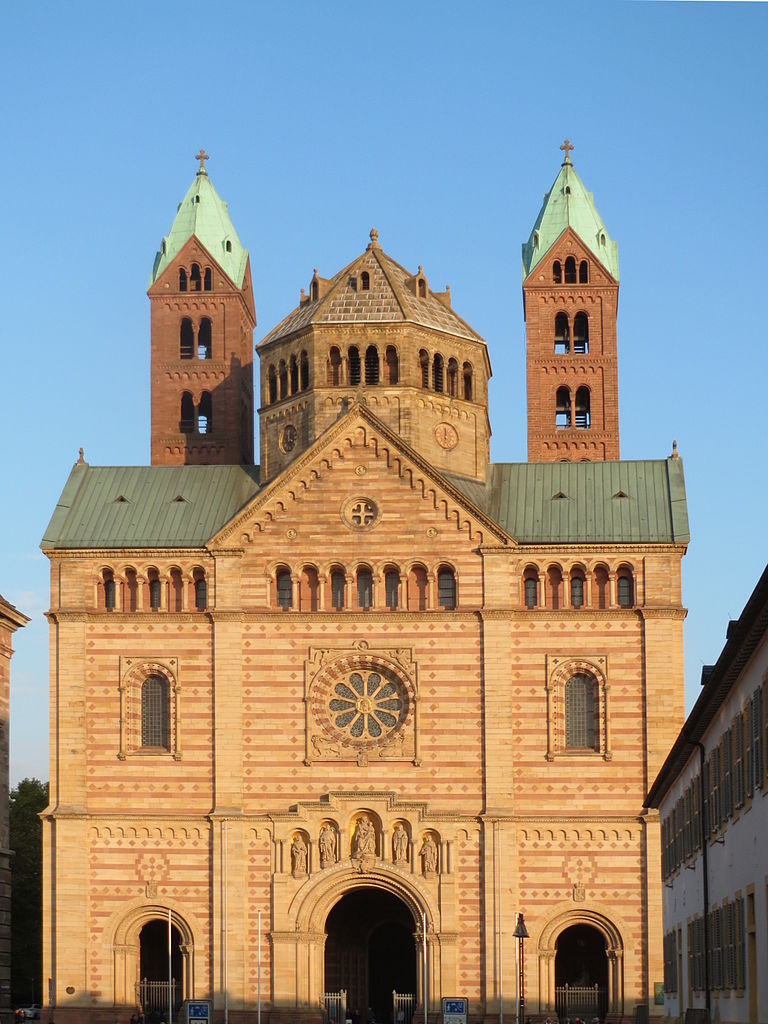

Speyer Cathedral is a large historic church located in Speyer Germany. The building has a foundation dating all the way back to the 11th century, with a majority of its construction taking place during the Romanesque Age. Like so many other cathedrals across Europe, Speyer Cathedral remained a constant work in progress, and the front facade was still incomplete up until the Revival Period. But, during the late 19th century there was a large push to complete the cathedral, and a narthex was added in the 1850s. The addition was designed in the Romanesque Revival Style and was meant to replicate the existing architecture of the rest of the building. In the image above you can see the addition in the foreground, with the older building in the background. Although the two parts aren’t an exact match, you can see a strong unity between the existing Romanesque portion and the new Romanesque Revival portion,
10. Royce Hall at UCLA – Los Angeles, California, United States
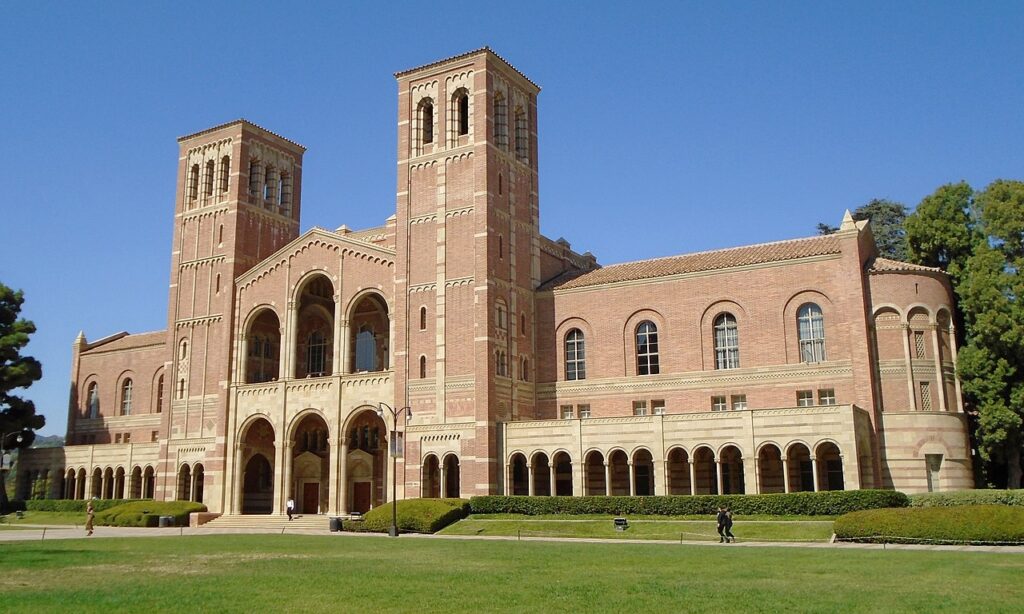
Many of the most prestigious colleges in The United States were founded in the 1800s, and as a result, many of these institutions contain an abundance of Revival Style Buildings. Royce Hall at the University of California is a great example of this. Royce Hall bears a very close resemblance to the cathedrals of the original Romanesque Age thanks to its use of round arches and simple geometries. Although Royce Hall may look like a religious building, it actually contains offices, classrooms, and a large open space that is used as a concert hall and auditorium.
11. Minneapolis City Hall – Minneapolis, Minnesota, United States

Completed in 1909, Minneapolis City Hall is a large Romanesque Revival Building located in Minneapolis Minnesota. The building houses the Minneapolis City Council and also serves as a local courthouse. Like many other examples of Romanesque Revival Architecture, the building contains a slender tower at the center of the front elevation. This feature mimics many of the Medieval forts and castles that were common throughout the original Romanesque Age. But the tower at Minneapolis City Hall is an aesthetic feature that was never actually intended for defense. This idea of incorporating older building components but not actually using them for their original purpose can be found throughout the Romanesque Revival Style.
12. Ontario Legislative Building – Toronto, Ontario, Canada

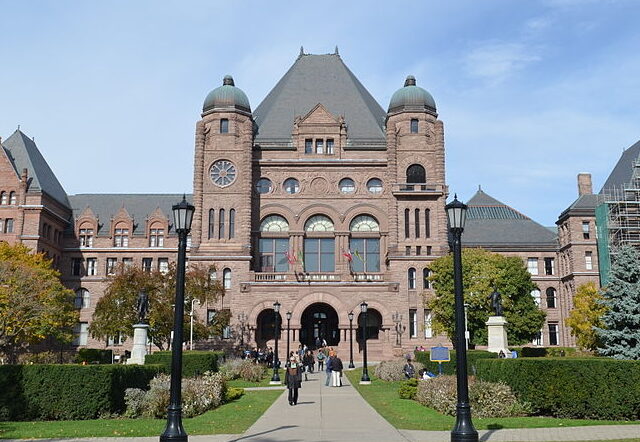
Located at the edge of a large urban park in Toronto Canada, the Ontario Legislative Building is an impressive work of Romanesque Revival Architecture that was completed in 1909. The exterior is made almost entirely from Granite, and it contains an assortment of openings both big and small. Many Neo Romanesque Buildings contain smaller windows as a way to replicate the early medieval buildings of the Romanesque Age. However, thanks to new emerging technologies and advances in masonry construction, these small windows weren’t as necessary in the Revival Period. Many Romanesque Revival Buildings utilize things like Steel Lintels so they can span larger distances. Developments like this greatly influenced the capabilities of 19th-century construction, and you can see a variety of forms in the buildings on this list that would have been unheard of back in the original Romanesque Age.
13. American Museum of Natural History – New York City, New York, United States
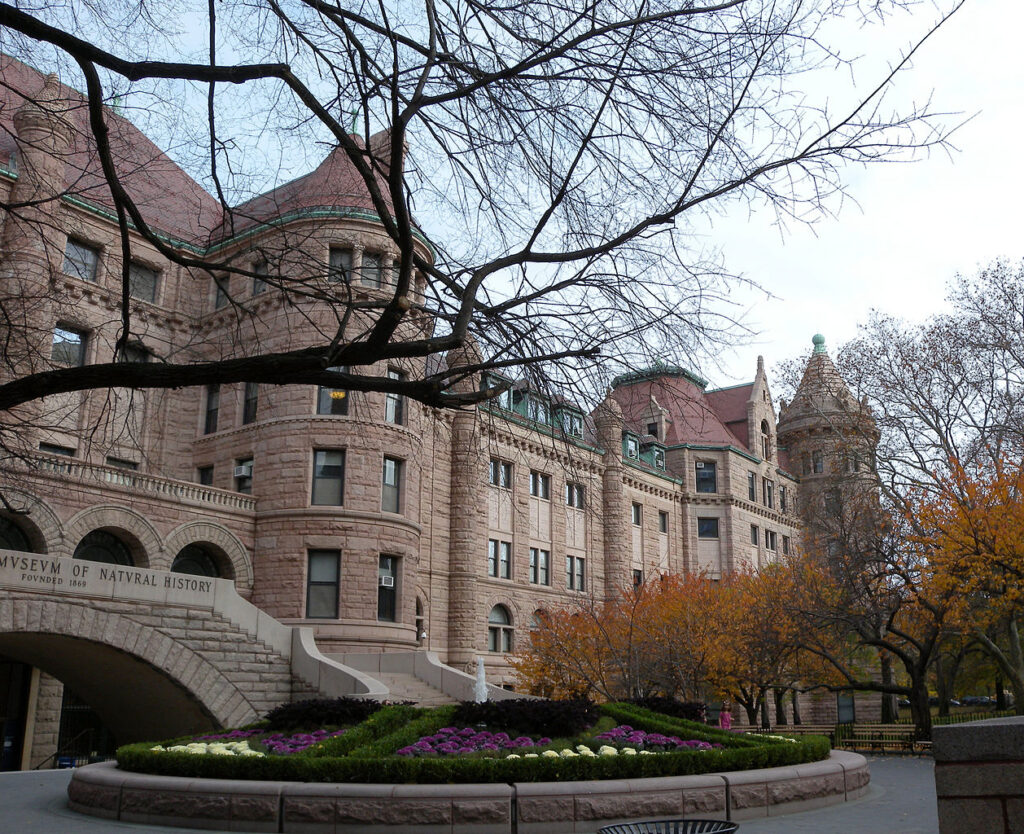
Located on the western edge of Central Park in New York City, the American Museum of Natural History is one of New York’s most well-known museums. It’s composed of dozens of different buildings which were built beginning in the mid-1800s. The Romanesque Revival Portion of the museum was built in stages beginning in the early 1900s. The Romanesque Revival wing is made from two different shades of red sandstone, and the entire design was heavily influenced by the works of H.H. Richardson and the Richardsonian Romanesque Style.
14. Austin Hall at Harvard University – Cambridge, Massachusetts, United States

Located in Cambridge Massachusetts, Harvard University is one of the world’s most well-known & prestigious colleges. The entire campus is filled with impressive works of architecture, both new and old. There is a large assortment of Revival Style buildings, and one of the most notable of these is Austin Hall. Austin Hall was constructed in 1881, and designed in the Romanesque Revival Style. It’s actually one of two great examples of Romanesque Revival Architecture on the campus, the other being Sever Hall. Harvard is also known for its many NeoClassical Buildings as well as for Memorial Hall, which is a great Gothic Revival building located not far from Austin Hall.
15. Cincinnati City Hall – Cincinnati, Ohio, United States
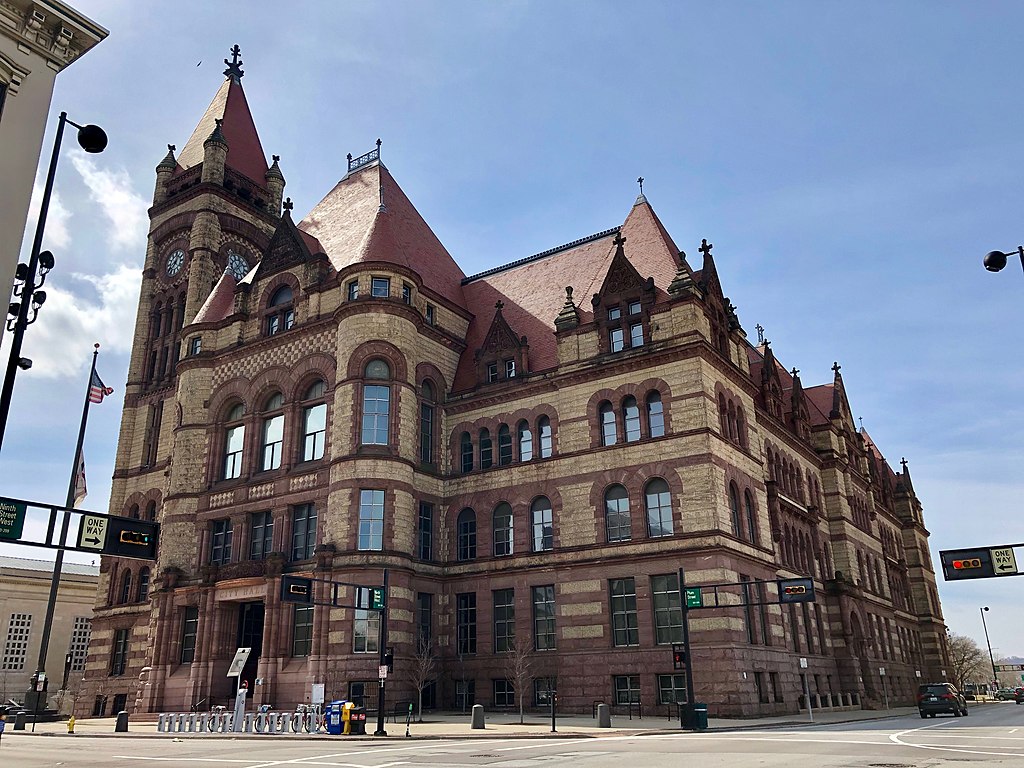
Cincinnati City Hall is one of the main government buildings in Cincinnati Ohio. It was completed in 1893 during the peak of the Revival Era. It’s designed in the Romanesque Revival Style, and it resembles many of the famous buildings designed by American Architect H.H. Richardson. Like Boston’s Trinity Church, Cincinnati City Hall is known as an example of Richardsonian Romanesque, which is a subtype in the overall Romanesque Revival Style. Today Cincinnati City Hall still houses the local government for Cincinnati, and it’s currently listed as a National Historic Landmark.
16. Westminster Castle – Westminster, Colorado, United States
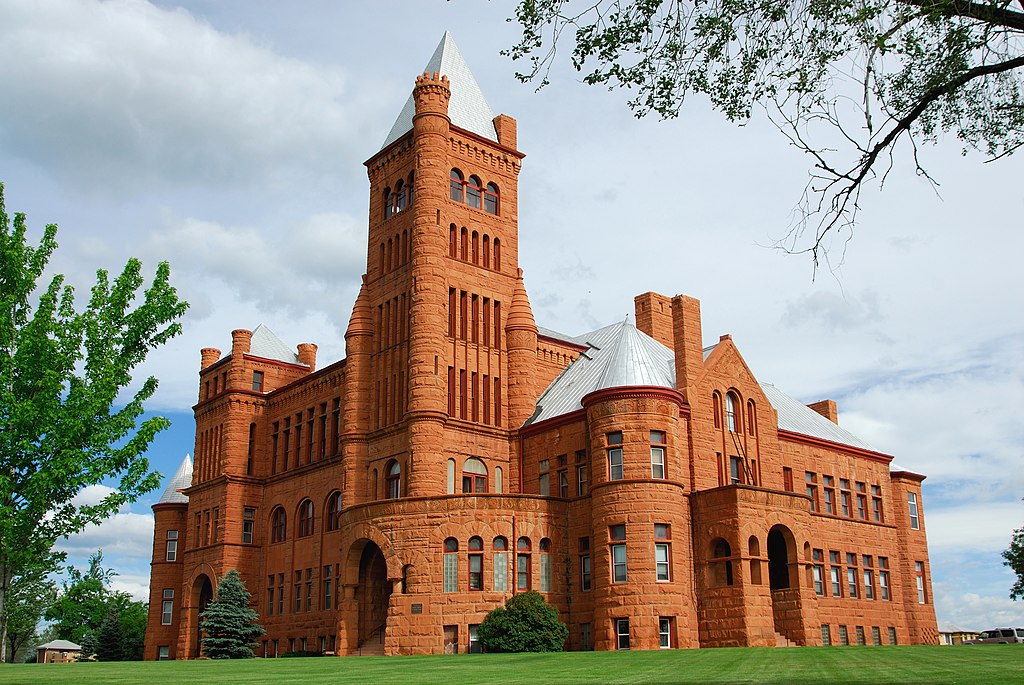
Built in 1892, Westminster Castle is a great example of late 19th-century Romanesque Revival Architecture. The building itself has a long and complex history. It was originally built as part of a university, but the school closed down in the mid-1900s. It was later taken over by a church, and then a different school. The building’s architect was Stanford B. White of the famed design firm, McKim, Mead, and White – a New York-based architecture firm that designed some of the most iconic buildings from the Revival Age. Today Westminster Castle is still used as part of a school in the town of Westminster and the building is protected as a historic landmark.
17. Cambridge City Hall – Cambridge, Massachusetts, United States

Cambridge is a city in Massachusetts located just north of the Charles River from the state capital, Boston. Cambridge is known for its prestigious universities including Harvard and MIT. Cambridge City Hall was constructed in 1889 and is one of the many great examples of Romanesque Revival Architecture located in the Northeast Region of the United States. The building contains all of the classic traits of the Neo Romanesque Style. These elements include thick walls, small windows, round arches, and the central tower on the front elevation. Cambridge City Hall is also an example of Richardsonian Romanesque, which was a particularly popular style in Massachusetts.
18. Woburn Public Library – Woburn, Massachusetts, United States
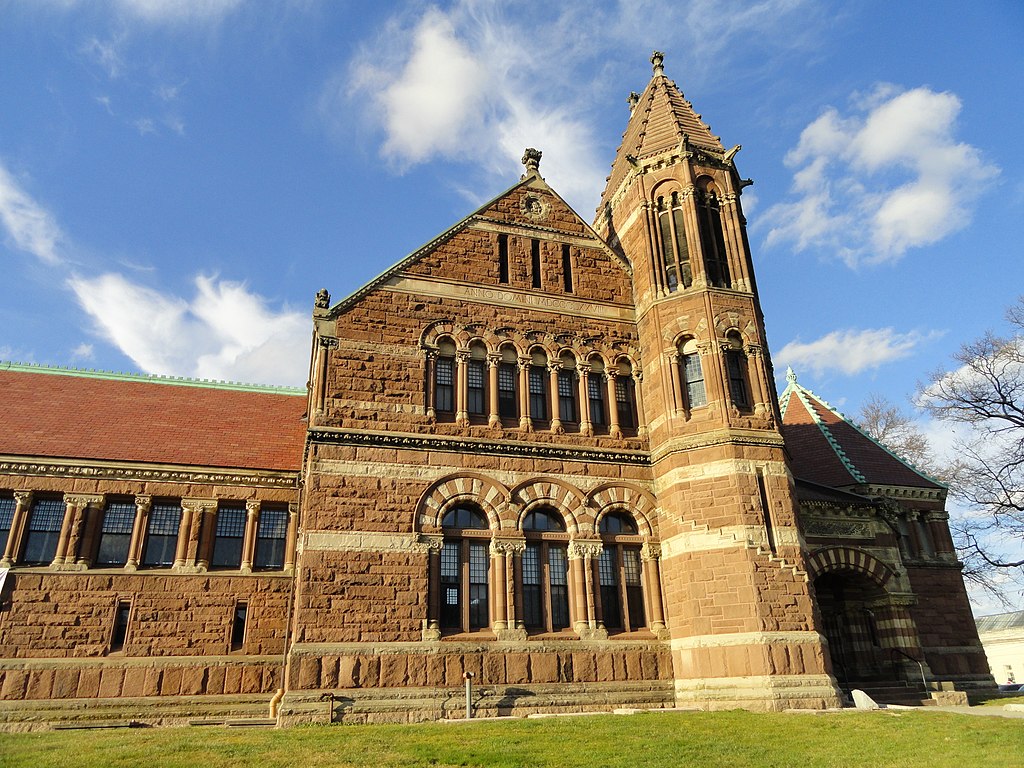
The Woburn Public Library is an iconic work of Romanesque Revival Architecture located in Woburn Massachusetts. The building was designed by H.H. Richardson and it is one of his lesser known works. The library resembles many other buildings on this list including Cincinnati City Hall and the Old Toronto State House. There are a variety of libraries in the Eastern Part of Massachusetts that were constructed in this same style, and although not as popular as they once were, these libraries are still an important part of local communities.
19. Old Post Office Building – Washington DC, United States
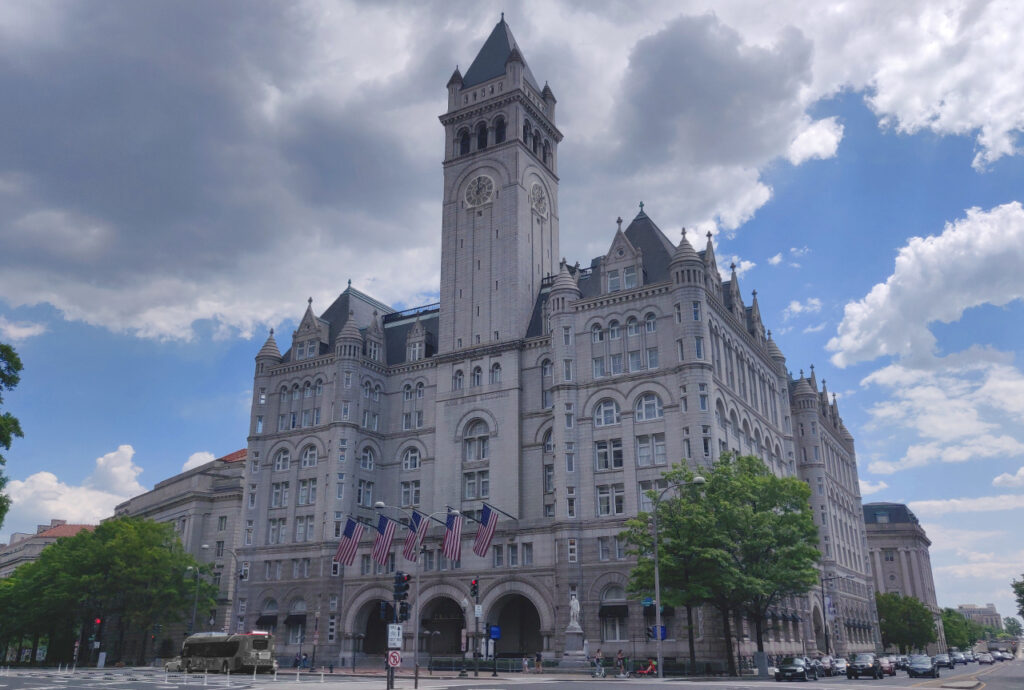
Before the days of the internet and email, the US Post Office was one of America’s most vital organizations. As a result, many post offices from the late 1800s were much grander and more lavish than the post offices of today. The Old Post Office Building in Washington DC was completed in 1899 and was designed in the Romanesque Revival Style. It was used as the main post office for all of DC until it was repurposed in the early 1900s. Over time various renovations and alterations were completed in the building, but the overall exterior hasn’t changed much thanks to its status as a National Historic Landmark. Today the main atrium has been completely enclosed by a modern-day skylight and most of the building systems have been upgraded to 21st century standards.
20. Illinois Institute of Technology Main Building – Chicago, Illinois, United States
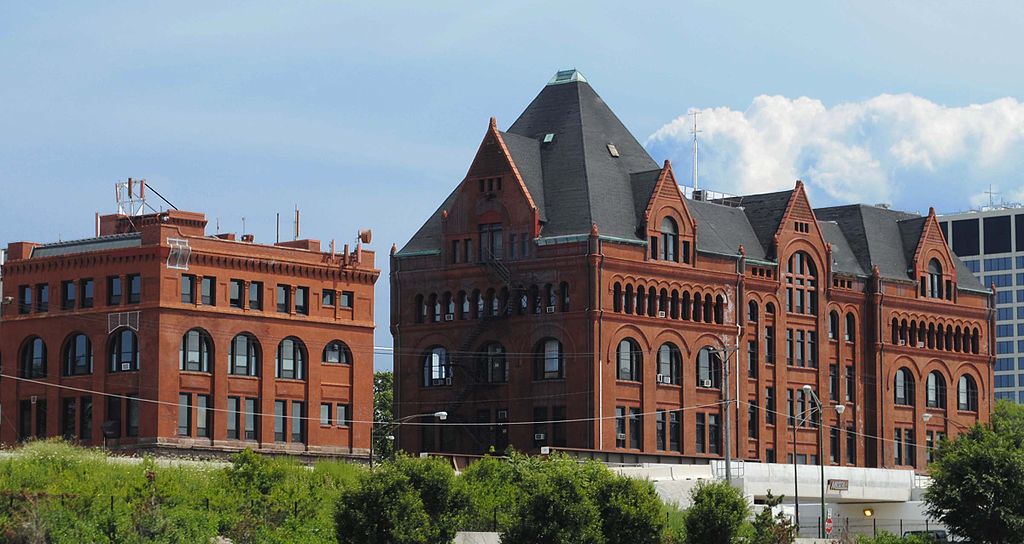
The Illinois Institute of Technology is a prestigious school located in Chicago. Its campus contains a wide variety of buildings, including many Revival-Age structures among other modern buildings. The school is also noteworthy for having several buildings by the famous architect, Ludwig Mies van der Rohe. One of the campus’s oldest buildings is known colloquially as the “main building”, and it was completed in 1893 in the Romanesque Revival Style. The Main Building contains all of the classic elements in Romanesque Design, such as rounded arches, simplified geometries, and small windows.
Norman Revival Architecture
Norman Revival Architecture is a subtype of Romanesque Revival Architecture. Norman Revival buildings are designed to replicate much older versions of Norman Architecture, which was a building style that was popular in England, Scotland, and Whales during the Middle Ages,
Below is an image of Penrhyn Castle, located in Wales. This building was constructed in the mid-19th century, in the Norman Revival Style, and it is meant to mimic other Norman Castles found throughout this part of the United Kingdom.
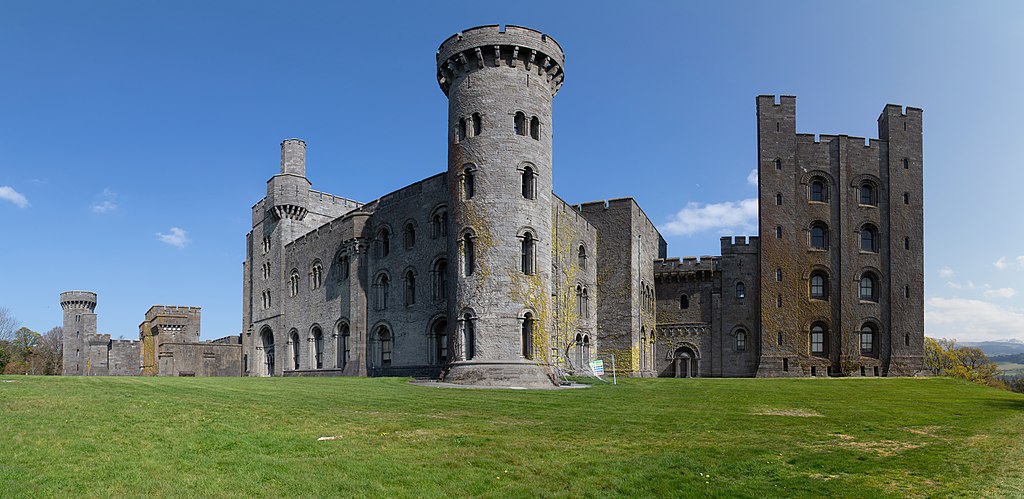
Richardsonian Romanesque
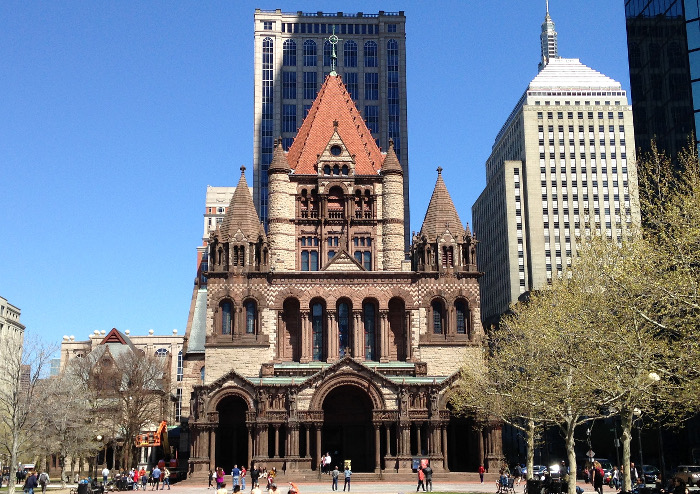


Richardsonian Romanesque is another subtype within Romanesque Revival Architecture. Richardsonian Romanesque is named for one of the greatest architects from the Revival Period, Henry Hobs Richardson. He designed several of the important buildings on this list, and his work has remained very influential throughout the last century. Countless examples of Richardsonian Romanesque Architecture can be found in the United States, particularly in states like Massachusetts, New York, and Illinois.
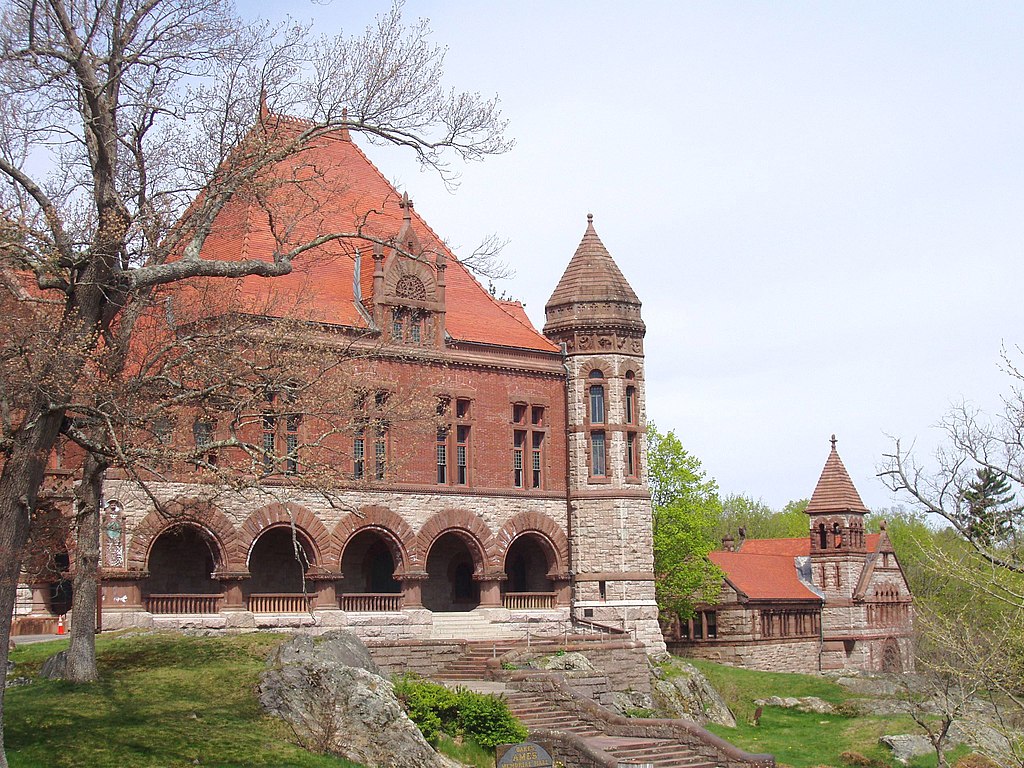
H.H. Richardson is possibly the most famous architect from the Revival Era of the 19th century, and he is known as the Father of Richardsonian Romanesque. The image above shows a collection of his buildings known as the “H.H. Richardson Historic District of Easton Massachusetts.” These various buildings include a library, a town hall, and a railroad station, and they all share the same characteristics found throughout Romanesque Revival Architecture.
Conclusion
The Revival Movement was one of the greatest phases in Architectural History, and this movement has given us some of the world’s most iconic buildings. Although there were many different Revival Styles, Romanesque Revival is one of the most well-known and prolific building forms from the era. Romanesque Revival Buildings can be found all over the world, and there is a high concentration within Canada and the United States. So many of these buildings are still standing today, and they will continue to stand for centuries thanks to their thick, sturdy masonry construction.
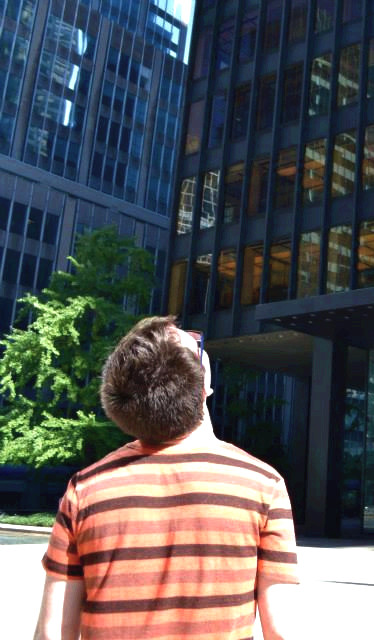
- About the Author
- Rob Carney, the founder and lead writer for Architecture of Cities has been studying the history of architecture for over 15 years.
- He is an avid traveler and photographer, and he is passionate about buildings and building history.
- Rob has a B.S. and a Master’s degree in Architecture and has worked as an architect and engineer in the Boston area for 10 years.
Like Architecture of Cities? Sign up for our mailing list to get updates on our latest articles and other information related to Architectural History.
